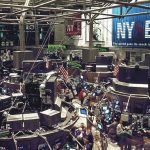How are companies chipping away at the next generation of big, hairy, audacious goals (BHAGs)? Read on …
A comprehensive look at IKEA’s new holistic impact measurement system
By Richa Agarwal
IKEA’s Peter Jones | Image credit: SB/Twitter
With the approach of the “4P” program — which focuses on people, planet,
profit, and perception — IKEA is moving towards meeting its sustainable
goals for 2030. During his Tuesday morning keynote, Peter Jones, Head of
Sustainability Analytics and Impacts at IKEA, gave an overview of the program
that the company is spearheading, regarding the impact and their journey to
becoming a sustainable brand by 2030.
IKEA has been imagining a future for value creation and as Peter pointed out,
the first task is to measure what the company is promising. Jones pointed out
that some impacts are easier to measure than others, but the company has defined
9 KPIs under its People and Planet
Positive
initiative that are centered around three areas:
- health and sustainable
living - circular
and climate positive - fair and equal.
IKEA is already producing more renewable energy than it uses; and how talking
the language of business in the environmental, social and governance (ESG) realm
can help accelerate the process of implementing changes in the business space
along with the language of impact for performance and value. Jones said that it
was okay for companies to not have very concrete plans or all the answers at the
start, but it was important to get
going
and start amassing small wins, while doing a comprehensive analysis on the side
to get bigger wins in the future.
In a subsequent session on Wednesday morning, Jones was joined by his colleagues
— Annamaria Malegh, Global Sustainability Analytics Leader Social & Behavior
at IKEA; and Jorge Castro, Sustainable Impact Leader — for a candid discussion.
One of the questions from the audience was about the increase in sales IKEA had
when it began its sustainability
campaigns.
Malegh mentioned that one of the main components of IKEA products is always the
design, so that is what the company led with; but also that half of IKEA’s
product range has some sustainable features — whether in terms of material,
quality, source or social/entrepreneurial innovation. Selling based on
sustainability depends on the maturity of the consumers understanding of
sustainability; for some, the bar is just on whether the product is non-toxic or
sourced fairly. Giving more information on sustainability to their customers has
helped sales globally by approximately 15-20 percent.
Another audience question was around how IKEA is setting about implementing its
People Planet Positive goals, and if it is exploring offsets. Jones said IKEA is
not investing in offsets but is working on other ways to reduce greenhouse gas
emissions from its entire value chain — calculating its Scope 3
emissions,
as Castro pointed out — with a goal to be climate positive by 2030.
Castro asserted IKEA has worked on sustainability for years — it is now just
part of the mainstream discussion; he said the company began by mapping what
they could to see what fit well with the company’s core values. IKEA continues
to pilot different initiatives with a focus on customers, companies and
communities; enabling them to measure impacts qualitatively and quantitatively.
He believes that sustainability is a journey and not a destination.
Defining, setting and achieving plastic-neutrality targets
By Richa Agarwal
Although a wonder material, the enduring nature of plastic has become one of the
biggest environmental concerns crippling our planet. In this engaging panel,
leading industry experts shared insights on how they are defining and/or dealing
with plastic neutrality for their companies and industries. The panelists
represented different stakeholders in plastic innovation, and how it varies for
companies in terms of product, manufacturing, packaging and use amongst
employees. The panel, moderated by Salterbaxter’s Philip Clawson, had
several key highlights:
Innovative software consultancy
As pointed out by James Sullivan, Head of Global Sustainability Innovation
at SAP, the software giant is helping other
businesses recognize the value in plastic neutrality, while providing them
resources required for action. Last year, it launched the Plastics
Cloud
to push the 2030 Agenda for Sustainable Development through materials and better
data collection and management. Sullivan said SAP is involved in plastic waste
because it believes that resource productivity is at the heart of the connected
intelligent enterprise — a critical part of a zero-waste world. So, with a goal
of creating value on many fronts for and with their customer companies, SAP set
out to find answers for this humongous problem. The company has done research on
understanding consumer behavior with respect of plastic consumption and has
worked on design thinking with their customers.
Sustainability strategy firm
While highlighting the gaps businesses are facing in terms of taking the total
action for plastics, Valutus founder Daniel Aronson
pointed out that there is a problem in how we define and compare different types
of plastics, as they have a different effect. He said it is important to
quantify not just by weight but by the impact of the type of plastic, so that we
have a clear picture of what data we have and what is missing. Aronson and his
team developed an enormous data table help companies quantify plastic’s true
impact. He said that with our conflicting approaches to plastic usage, the fact
that we look at how much but not how bad makes it hard to get from where we
are to where we need to go. He stressed the need for standardization in this
regard.
Product-based company
John Pflueger, Principal Environmental Strategist at Dell, described how
Dell replaced its 2020 sustainability targets with a 2030 strategy, which has
more extensive metrics — including a moonshot goal of going completely
circular.
He said that Dell has been looking into the problem of plastics for almost a
decade; and in 2013, committed to use 50 million pounds of recycled
plastics
in its products by 2020 — a target that was doubled to 100 million in 2017. They
are piloting session to close the loop for their take-back systems. The company
is exploring alternative materials, including ocean
plastics,
in its bid to achieve circularity.
Flueger mentioned that Dell is committed to one-to-one material recovery by
2030, amplifying its current take-back program 10-12 times. He said its goal for
all of its packaging to be made entirely of renewable and all recyclable
materials is proving one of the most difficult tasks.
Pioneering plastic offsets
Svanika Balasubramanian, co-founder of
RePurpose, introduced her startup — which is
creating the world’s first offset mechanism for plastics, and offering companies
solutions and certification for plastic neutrality. While her team was looking
for solutions, they found many people across Southeast Asia are working on
solutions around informal
recycling
— for example, through waste pickers. RePurpose started with the idea that while
companies are taking actions for the future and transiting to a circular
economy, they could offset their plastic impacts by investing in companies and
initiatives that are working on solutions on the ground to support and
strengthen them. As customers are demanding solutions today, RePurpose is
working with businesses that have defined their plastic-neutrality goals by
creating a pool of money in the form of a “plastic-neutral fund,” which is being
used to fund solutions and innovation, and is feeding back data to companies,
hence closing some loops.
Certified TBL Orgs: The world’s first triple-bottom line certification credential
By Leila Goldmark
Mark McElroy | Image credit: SB/Twitter
On Tuesday afternoon, Mark McElroy, CEO of SustainAccounting LLC; and
Jane Hwang, President & CEO of Social Accountability International
(SAI), used their keynote to announce their partnership and launch the world’s
first triple-bottom-line (TBL) certification
credential.
While prior guidance has encouraged context-based sustainability
reporting
for a number of years, there has been no specific accounting guidance or
standard to achieve this goal. The new TBL certification credential will fill
the existing gap, offering a context-based accounting tool to assist rigorous
and actionable sustainability performance measurement and reporting.
What is the TBL accounting framework?
The term “triple-bottom line accounting” was coined by John Elkington in
the 1990s as a way to interpret the performance of corporations in more than
just economic or financial terms. While this concept was not new, Elkington
capitalized on it by looking at the carrying capacity of all types of capital —
natural, economic, and social capital.
Why now? The history of context-based sustainability reporting
The expansion to context-based TBL (CTBL) thinking began in 2002, when the
Sustainability Context Principle was introduced in GRI’s G2 Standard. This
principle has persisted over the years and survived many revisions of the GRI
reporting standard; it remains a central core sustainability accounting
principle today. But, no guidance on how to actually do context-based TBL
accounting was ever developed.
McElroy quotes AllenWhite, one of the founders of GRI, to explain:
*In the course of wide-ranging stakeholder consultations, it became clear
that true sustainability reporting at the enterprise level must be
contextualized within boundaries that define the ecological, social, and
economic system limits, both upper and lower, ceilings and floors. I argue
that absent context even if all enterprises continuously improve
performance, the collectivity may violate boundaries that define a thriving
regenerative world. Sustainability measurement without context simply is not
sustainability reporting at all. *
McElroy highlighted two additional events in the TBL timeline:
the invention of the concept of double-bottom line bookkeeping by Luca
Pacioli in 1494; and the passage of the US Securities Act of 1933, which
requires financial disclosure. Thus, for financial reporting, people created
standards for measuring performance, and then went on to develop standards for
how to report results. In the sustainability field, people have done things
backwards, developing standards for sustainability reporting, but never
back-filing how to actually measure and address the accounting.
What will CTBL do?
Establishing a CTBL certification will fill the existing sustainability context
gap. As envisioned, the TBL accounting requirements will fall into two
categories — organizational and operational. It will:
- make sustainability context in GRI reports possible by providing the missing
standard; - Incentivize and reward TBL accounting with a highly visible credential; and
- make sustainable performance possible, since measurement must come
first.
Hwang explained that TBL accounting ultimately has to be something that is not
externally imposed; it must be fundamental to how every business operates. The
goal will be to “build on these objective, normative principles of TBL
accounting; and then to enhance and build consensus through multi-stakeholder
consultations and engagement.”
SAI currently is developing the standard, the training and certification tools;
and is seeking input and partnership from the sustainability community.
How standardized social outcomes demonstrate corporate impact
By Leila Goldmark
Jason Saul and Arlene Isaacs-Lowe | Image credit: Beaumonde Originals/Sustainable Brands
Wrapping up the final day of New Metrics, Sustainability Communicator & Media
Architect Nick Aster facilitated a conversation between Jason Saul, CEO
of Mission Measurement and founder of the
Impact Genome Project®; and Arlene Isaacs-Lowe, Global Head of CSR at
Moody’s. Saul walked us through the research and
development of The Impact Genome® — a platform
that standardizes the way social programs measure, evaluate and report outcomes;
and Isaacs-Lowe explained how this valuable tool is being used by companies to
inform and target their sustainability and philanthropy program initiatives.
The problem: Previous efforts standardizes metrics, not outcomes
“Effectively measuring social impact is challenging, because no standards exist
— no one can compare apples to apples,“ Saul said. He explained that previous
attempts to quantify social impact fell short because:
- They tried to standardize at the wrong level — forcing standardization at the level of the metric, not the level of outcome. For example, if we’re trying to reduce poverty, measuring the number of people trained or getting a subsidy does not tell us if people actually become financial stable due to those efforts.
- There is no standard-setting body in this field to say what outcomes should be measured.
- There are no benchmarks, making it hard to incentivize measurement when we don’t know the cost per unit of outcome. We don’t know “good” means.
The solution: The Impact Genome measures outcomes, sets benchmarks
Saul explained how The Impact Genome provides the missing metrics, stating that,
“through the Impact Genome, we’ve developed evidence-based standards and now
have benchmarks for common outcomes across the most critical social impact
areas. Organizations find value in the common language of the standard outcomes,
benchmarks to understand their cost per outcome; data to build grantee capacity,
demonstrate ROI and drive ultimately more impact.”
The Impact Genome® is a publicly funded global effort that’s backed by
foundations and governments around the world. Researchers analyzed 11,000
programs, identifying 77,000 outcomes. Looking for common patterns, 132
prominent outcomes were grouped into 12 categories, or social “genomes” —
Education, Economic Development, Public Health, Youth
Development, International Development, Human Services, Criminal
Justice, Sustainability and Environment, Science and Technology,
Arts, Culture and Identity, and System Change.
Notably, while many social metrics measure direct services, the System Change
genome provides benchmarks and metrics for longer-term capacity building,
leadership and policy change, as well.
Isaacs-Lowe explained that companies and foundations finally have a practical
research tool to help them understand their potential return on social
investments and guide their investment strategies. With many programs now
reporting, it is possible to research the average investment amount and the cost
per unit of outcome for over 100 outcomes.
In response to audience concerns that this cost-benefit approach could pressure
programs to focus on more efficient, “low-cost” initiatives in their attempts to
win funding, she stressed that Moody’s looks to The Impact Genome benchmarks as
a minimum floor for investment, not as a strategic guide for what outcomes it
chooses to work on. For example, a company choosing to work on reducing
homelessness can look to those benchmarks, then add what may be needed to
address more difficult cases (e.g. homeless populations in rural areas, or those
with additional mental health concerns).
The Impact Genome is a revolutionary tool that can be used by governments, NGOs,
and public and private sector organizations. It is freely available for all to
access and explore.
Source: Sustainable Brands – Latest News






